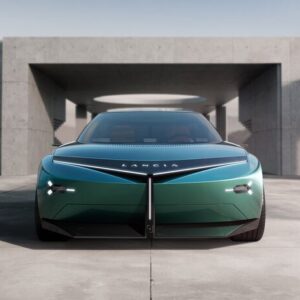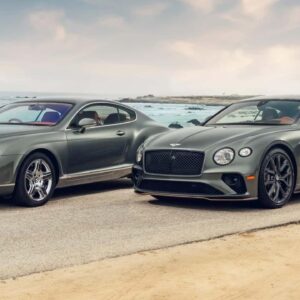We’ve already shown the concept drawings for the upcoming T.33 Spider from Gordon Murray Automotive a few days ago in our article for the final sign-off on the T.50. Still, today we have the official press release photos of this brand-new model from this UK-based global luxury brand, this is also the very first V12 Spider supercar from Gordon Murray by the way, and it is strictly limited to just 100 units with the famous 617 PS Cosworth GMA.2 engine, one little detail: the development of the T.33 Spider has been done in parallel with the regular T.33, using the same ultralight carbon fiber monocoque construction.
Professor Gordon Murray CBE said “When drawing a car I imagine what it’s going to feel like to sit in, and how it will feel to drive. So from the first sketch, I knew that, with its open cockpit and the incredible Cosworth GMA.2 V12 engine right behind you, the T.33 Spider would deliver a truly involving driving experience that’s quite unlike anything else. And while it’s still a mid-engine supercar I wouldn’t accept any compromise on usability: this is why the T.33 Spider is unique in the supercar sector in delivering both onboard roof storage and a 295 liter luggage capacity”.
Phil Lee, Gordon Murray Group CEO, said: “The arrival of the T.33 Spider sees Gordon Murray Automotive firmly established as a global OEM. Customer deliveries of our halo T.50 model – the world’s most driver centric supercar – are due imminently, and the track-only T.50s will be in production later this year. In addition, by the end of the year our production team will have moved into our new bespoke global headquarters at Highams Park, Windlesham, where both the T.33 and the incredible new T.33 Spider will be lovingly hand-built. I am incredibly proud of the fact that, less than three years since the reveal of T.50, Gordon Murray Automotive is a global OEM with an outstanding portfolio of four supercars: T.50, T.50s, T.33 and now T.33 Spider.”
Like its coupe stablemate, T.33 Spider is the very embodiment of GMA’s Return to Beauty ethos, but with looks that promise an even more involving driving experience. Inspired by iconic designs from the 1960s but with the perfect proportions and flowing surfaces crafted from carbon fiber and executed with purity and relentless attention to detail, this is a supercar like no other. To deliver the design vision defined by the very first sketches, every surface from the A-pillar backward is unique to the T.33 Spider, yet it clearly shares its DNA with the T.33.
Gordon Murray said “From the very beginning I knew that one of the biggest challenges in designing the T.33 Spider would be keeping the purity, balance and overall beauty of the T.33. That’s why I sketched both versions at the same time to make sure that the proportions would work”.
The fixed section of the roof features elegant buttresses which blend harmoniously into the rear deck, behind which are louvers which further aid engine cooling. The ram induction airbox, mounted directly to the engine itself and a hallmark feature of the T.33, becomes even more distinctive on the Spider, especially when the roof panels are removed.
Simple, elegant, analog: the T.33’s interior embodies these defining qualities and delivers a truly driver-focused environment. Befitting a supercar, the focal point of the instrument cluster is the 120mm, floodlit, and defiantly analog centrally-mounted rev counter. Calibrated to 11,100 rpm it clearly signals the Cosworth GMA V12’s performance potential. On either side are secondary displays for climate control and infotainment, the latter featuring wireless Apple CarPlay and Android Auto connectivity.
All of the main controls are beautifully tactile, with the carbon fiber steering wheel trimmed in leather and the perfectly-weighted pedals, gear shift lever, and switchgear machined from aluminum alloy. The lightweight, race-inspired carbon fiber seats are trimmed in a combination of leather and Alcantara. As part of the customer experience, each car is perfectly tailored to its owner. One of the unique interior features distinguishing the T.33 Spider from the coupe is that the rear bulkhead trim between the two seats is now body colored. With the roof panels removed and the rear glass down, this subtly enhances the feeling of openness through the exterior color flowing into the cabin.
Developed in parallel with the coupe, the T.33 program was Spider-led, which meant that all torsional rigidity targets were set for the Spider body structure. This ensured no compromises to structural integrity and avoided the weight increases which typically arise from the traditional approach of adding reinforcements and bracing. As a result, and a consequence of GMA’s obsessive focus on weight reduction – down to single grams from every component – the T.33 Spider has a target dry weight of 1,108 kg, just 18 kg more than the coupe, and will deliver the same superlative driving experience.
Following motorsport practice, the powertrain of the T.33 Spider is semi-structural, with the rear suspension mounted directly to the transmission casing. To maximize the weight reduction and vehicle dynamics benefits this brings without undue noise, vibration, and harshness being transmitted into the cabin, the system features GMA’s Inclined Axis Shear Mounting (IASM). The IASM system uses flexible mountings to deliver exactly the right amount of isolation required for refinement while at the same time enabling precise handling.
All the T.33 Spider’s vehicle dynamics attributes are engineered around these tires, which are designed to deliver a combination of excellent wet and dry performance on the road as well as occasional track use. And, compared to fully bespoke tires, they offer the additional advantage of being readily available – when required, customers will not have to endure long lead times for them to be delivered to their chosen service center.
Foregoing turbocharging for the compromises this imposes in throttle response and aural quality, the GMA.2 is naturally aspirated, fed via the ram air scoop and four throttle bodies, together with two fuel injectors per cylinder. Together with the inherently low inertia afforded by the use of titanium for critical components such as the connecting rods, this combination delivers unrivaled responsiveness: 75 percent of the 451 Nm maximum rated torque is available from only 2,500 rpm, while 90 percent is maintained from 4,500-10,500 rpm. Maximum power of 617 PS is delivered at 10,250 rpm, with the engine electronically limited to an astonishing 11,100 rpm, at which point the driver is rewarded with an unmistakable 12-cylinder crescendo before shifting to the next gear. The complete engine weighs just 178 kg: this is the world’s lightest road car V12 engine.
In place of the signature orange cam covers used on the GMA V12 in the T.50, those on T.33 Spider, like the T.33, are finished in yellow – a color inspired by the distinctive paintwork of the Gordon Murray-designed 1972 Duckhams Ford LM race car. The T.33 Spider, like the T.33, will have EU and Federal type approval. Every one of the 100 production examples will be lovingly hand-built at Highams Park, GMA’s all-new bespoke headquarters at Windlesham in the UK, and each will be tailored to its customer’s specific requirements.
Exterior colors have been curated into four themes by the Design team. These four themes have been inspired by, respectively, GMA’s core values of Return to Beauty and Engineering Art, the Murray Atholl tartan – and then a final palette acknowledging Gordon’s love for a tropical shirt. Each specific exterior color is matched to a Design team-recommended interior specification – though customers are free to choose whatever they wish. Providing almost endless scope for personalization, customers may select different colors for the roof panels and rear deck. In addition to the ‘Design’ range of available exterior colors, customers can also opt to specify a bespoke paint made for special orders.
Continuing a customer experience second to none, GMA has ensured that owning a T.33 Spider will be as enjoyable as driving one. Headed by a Global Aftersales team, there are five Global Service Centres in select locations around the world: USA (East and West coasts), UK, Japan, and Abu Dhabi. All are staffed by expert technicians trained by GMA to service, maintain and repair these unique cars. The five Global Service Centres are supplemented by a network of 14 Service Support Centres, which are also staffed by expert technicians trained by GMA. When a customer takes their car to a specified Service Support Centre, GMA will either support the Service Support Centre or send its technicians to that center to carry out whatever work is required on the car to the same exacting standards applied when it was hand-built at Windlesham.
These Service Support Centre locations are Germany, Spain, the Kingdom of Saudi Arabia, the Kingdom of Bahrain, Hong Kong, Singapore, Taiwan, and Australia with a further six in key states of America. GMA’s network development will continue in line with its customer expectations.















